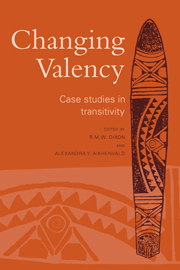Book contents
- Frontmatter
- Contents
- List of contributors
- Preface
- List of abbreviations
- 1 Introduction
- 2 A typology of causatives: form, syntax and meaning
- 3 Valency-changing derivation in Central Alaskan Yup'ik
- 4 Transitivity and valency-changing derivations in Motuna
- 5 Transitivity in Tariana
- 6 Voice and valency in the Athapaskan family
- 7 Valency-changing derivations in K'iche'
- 8 Valency-changing derivations in Dulong/Rawang
- 9 Valency-changing and valency-encoding devices in Amharic
- 10 Complex verb collocations in Ngan'gityemerri: a nonderivational strategy for encoding valency alternations
- 11 Valency-changing derivations in Tsez
- 12 Creek voice: beyond valency
- Index of authors
- Index of languages and language families
- Subject index
1 - Introduction
Published online by Cambridge University Press: 02 February 2010
- Frontmatter
- Contents
- List of contributors
- Preface
- List of abbreviations
- 1 Introduction
- 2 A typology of causatives: form, syntax and meaning
- 3 Valency-changing derivation in Central Alaskan Yup'ik
- 4 Transitivity and valency-changing derivations in Motuna
- 5 Transitivity in Tariana
- 6 Voice and valency in the Athapaskan family
- 7 Valency-changing derivations in K'iche'
- 8 Valency-changing derivations in Dulong/Rawang
- 9 Valency-changing and valency-encoding devices in Amharic
- 10 Complex verb collocations in Ngan'gityemerri: a nonderivational strategy for encoding valency alternations
- 11 Valency-changing derivations in Tsez
- 12 Creek voice: beyond valency
- Index of authors
- Index of languages and language families
- Subject index
Summary
This volume consists of a number of detailed case studies of transitivity across a selection of languages – from North, Central and South America, New Guinea, Australia, the China/Myanmar (Burma) border, North-east Africa and the Caucasus. In the introduction we summarize the theoretical presuppositions and parameters, suggest generalizations that can be made on the basis of comparison of the individual studies, and draw attention to useful directions for further research.
§1 describes varieties of predicate arguments and clause types. §2 deals with classes of verbs, and transitivity-encoding devices. Then §3 presents an overview of derivations which change valency. In §4 we discuss derivations which typically reduce valency – passive, antipassive, reflexive, reciprocal and anticausative (plus the ubiquitous middle). §5 considers derivations which typically increase valency – applicative and causative (there is a full discussion of causatives in chapter 2). In §6 we emphasize the need for a holistic approach; every derivational process is likely to have syntactic, semantic and discourse/pragmatic aspects, each of which interrelates with and helps explain the others. §7 briefly discusses the propensities of different groups of verbs – according to their semantics – for taking part in the various derivations that affect valency. In §8 we look briefly at syntactic alternatives to valency-changing derivations; in some languages there may simply be alternative construction types, with no derivational link. §9 gives a short preview of each of the following chapters. Finally, in §10 we suggest a number of fruitful lines for further research.
- Type
- Chapter
- Information
- Changing ValencyCase Studies in Transitivity, pp. 1 - 29Publisher: Cambridge University PressPrint publication year: 2000
- 128
- Cited by

